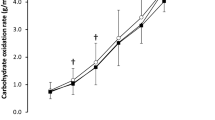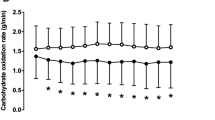Summary
The effect of substrate utilization manipulated by caffeine on post-exercise oxygen consumption was investigated in five untrained females (age=21±1.5 years), following 90 min of treadmill walking at 55% maximal oxygen consumption. Each subject participated in the two trials (control and experimental) within 2 weeks of each other. Immediately following the measurement of resting oxygen consumption, subjects consumed one of the two test beverages 60 min prior to exercise: 5 mg of caffeine per kg of bodyweight in 200 ml of orange juice (CA) or 200 ml of orange juice (C). Assignment of CA and C was made in a random, double blind fashion. Immediately prior to the exercise phase (0 min) resting oxygen consumption was again measured. Following exercise, subjects returned to the same pre-exercise sitting position where respiratory data was collected over 1 h. No significant differences were found in resting oxygen consumption and respiratory exchange ratio (R) prior to caffeine ingestion (−60 min). One hour after caffeine ingestion (0 min) oxygen consumption and free fatty acid (FFA) levels increased significantly compared to C. During and 1 h following exercise, oxygen consumption and FFA levels were significantly greater, with R values being significantly lower in CA compared to C. These findings provide further evidence that metabolic substrate is somehow implicated in elevating oxygen consumption following exercise cessation.
Similar content being viewed by others
References
Acheson KJ, Zahorska-Markiewicz B, Pittet MD, Anantharaman K, Jequier E (1980) Caffeine and coffee: their influence on metabolic rate and substrate utilization in normal weight and obese individuals. Am J Clin Nutr 33:989–997
Bahr R, Inges I, Vaage O, Sejersted M, Newsholme E (1987) Effect of duration of exercise on excess postexercise O2 consumption. J Appl Physiol 6:485–490
Bellet S, Kershbaum A, Aspe J (1965) The effect of caffeine on free fatty acids. Arch Intern Med 116:750–752
Bellet S, Kershbaum A, Finck E (1968) Response of free fatty acids to coffee and caffeine. Metabolism 17:702–707
Bellet S, Roman L, De Castro O, Kim KE, Kershbaum A (1969) Effect of coffee ingestion on catecholamine release. Metabolism 18:288–291
Bielinski R, Schutz Y, Jequier E (1985) Energy metabolism during the postexercise recovery in man. Am J Clin Nutr 42:69–82
Boothby WM, Rowntree LG (1924) Drugs and basal metabolism. J Pharm Exp Ther 22:99
Brozek J, Grande F, Anderson J, Keys A (1963) Densitometric analysis of body composition: revision of some quantitative assumptions. Ann N Y Acad Sci 110:113–140
Bruce RA, Kusumi F, Hosmer D (1973) Maximal oxygen intake and nomographic assessment of functional aerobic impairment in cardiovascular disease. Am Heart J 85:546–561
Casal DC, Leon AS (1985) Failure of caffeine to affect substrate utilization during prolonged running. Med Sci Sports Exerc 17:174–179
Chad KE (1988) The effects of intensity and substrate utilization manipulated by caffeine and diet, on post-exercise oxygen consumption. Thesis University of Queensland, Brisbane
Chad KE, Wenger HA (1985) The effects of duration and intensity on the exercise and post-exercise metabolic rate. Aust J Sci Med Sport 17:14–18
Chad KE, Wenger HA (1988) The effect of exercise duration on the exercise and post-exercise metabolic rate. Can J Appl Sport Sci 13:204–207
Costill DL, Dalsky GP, Fink WJ (1978) Effects of caffeine ingestion on metabolism and exercise performance. Med Sci Sports 10:155–158
Durnin JVGA, Womersley J (1974) Body fat assessed from total body density and its estimation from skinfold thickness: measurements on 481 men and women aged from 16 to 72 years. Bri J Nutr 32:77–97
Essig D, Costill DL, Van Handel PJ (1980) Effects of caffeine ingestion on utilization of muscle glycogen and lipid during leg ergometer cycling. Int J Sports Med 1:86–90
Falholt K, Lund B, Falholt W (1973) An easy calorimetric micromethod for routine determination of free fatty acids in plasma. Clin Chim Acta 46:105–111
Gaesser GA, Brooks GA (1984) Metabolic bases of excess post-exercise oxygen consumption: a review. Med Sci Sports Exerc 16:29–43
Grollman A (1930) The action of alcohol, caffeine, and tobacco on the cardiac output (and its related function) of normal man. J Pharmacol Exp Ther 39:313–327
Haldi J, Bachmann G, Ensor C, Winn W (1941) The effects on respiratory metabolism produced by equal amounts of caffeine in the form of coffee, tea and pure alkaloid. J Nutr 24:287
Hermansen L, Grandmontagne M, Maehlum S, Ignes I (1984) Postexercise elevation of resting oxygen uptake: possible mechanisms and physiological significance. In: Marconnet P, Poortman T (eds) Physiological Chemistry of Training and Detraining. Karger, Basel, pp 119–129
Horst K, Wilson RJ, Smith RG (1936) The effect of coffee and decaffeinated coffee on oxygen consumption, pulse rate and blood pressure. J Pharmacol Exp Ther 58:294–300
Ivy JL, Costill DL, Fink WJ, Lower RW (1979) Influence of caffeine and carbohydrate feedings on endurance performance. Med Sci Sports 11:6–11
Knapik JJ, Jones BH, Toner MM, Daniels WL, Evans WJ (1983) Influence of caffeine on serum substrate changes during running in trained and untrained individuals. Biochem Exerc 13:514–519
Maehlum S, Grandmontagne M, Newsholme EA, Sejersted OM (1986) Magnitude and duration of excess postexercise oxygen consumption in healthy young subjects. Metabolism 35:425–429
Miller DS, Stock MJ, Stuart JA (1974) The effects of caffeine and carnitine on the oxygen consumption of fed and fasted subjects. Proc Nutr Soc 33:28A
Newsholme E (1978) Substrate cycles: their metabolic energetic and thermic consequences in man. Biochem Soc Symp 43:183–205
Poehlman ET, Despres HB, Fontaine AT, Bouchard C (1985) Influence of caffeine on the resting metabolic rate of exercise-trained and inactive subjects. Med Sci Sports Exerc 17:689–694
Van Handel PJ, Burke E, Costill D, Cote R (1977) Physiological responses to cola ingestion. Res Q 48:436–444
Weir J, Noakes TD, Myburgh K, Adams B (1987) A high carbohydrate diet negates the metabolic effects of caffeine during exercise. Med Sci Sports Exerc 19:100–105
Author information
Authors and Affiliations
Rights and permissions
About this article
Cite this article
Chad, K., Quigley, B. The effects of substrate utilization, manipulated by caffeine, on post-exercise oxygen consumption in untrained female subjects. Europ. J. Appl. Physiol. 59, 48–54 (1989). https://doi.org/10.1007/BF02396579
Accepted:
Issue Date:
DOI: https://doi.org/10.1007/BF02396579




